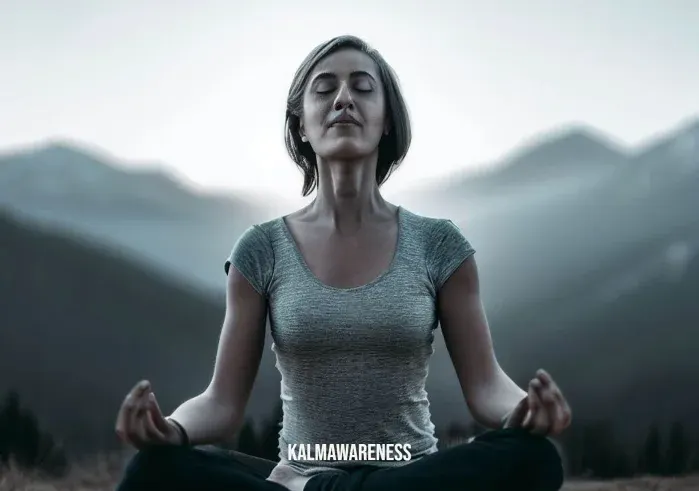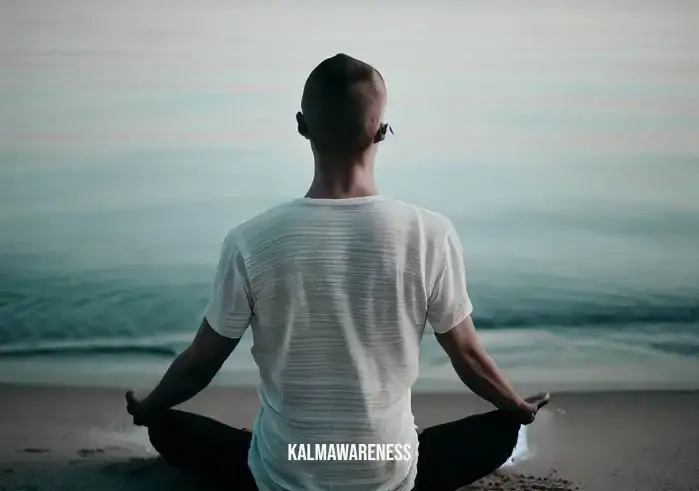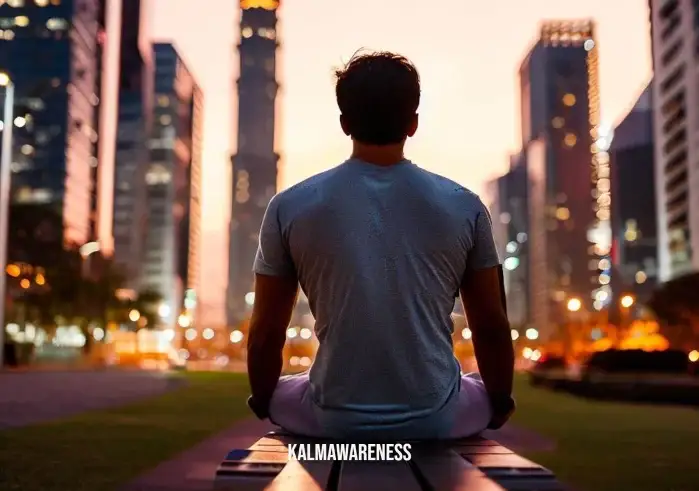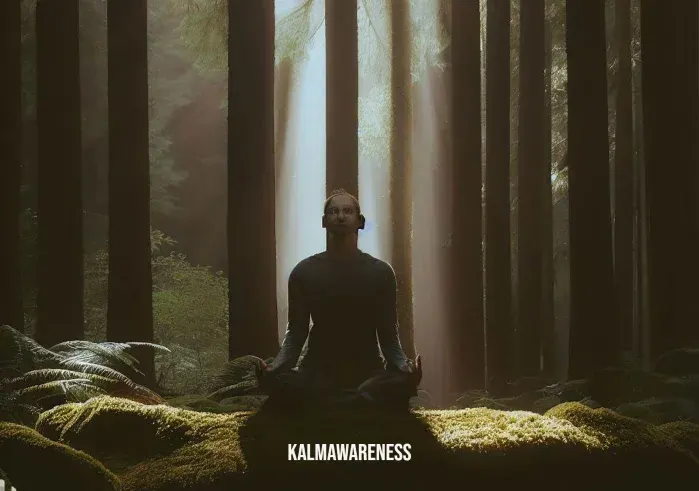The Importance of a Straight Spine in Meditation
Maintaining a straight spine during meditation is essential for promoting better energy flow, increased awareness, and deeper levels of relaxation. But why is it so critical? How does it affect your mindfulness and overall meditation experience? In this article, we will dive deep into the subject: How important is a straight spine in meditation?
The Science Behind a Straight Spine
A straight spine is a vital aspect of many meditation practices, and science has reasons for it. It has been observed that a well-aligned posture, with a straight spine, helps in regulating breathing, promoting better oxygen flow, and enabling deeper concentration during meditation. Moreover, in terms of energy flow, ancient traditions talk about the flow of ‘prana’ or ‘life force’ along the spine. A straight spine helps to maintain a clear path for this energy, connecting the base of your body to the crown of your head.
“Posture is not just about looking good or standing straight; it’s about creating a body-mind connection that fosters spiritual and emotional growth.”
A straight spine also has implications for maintaining balance, both physically and mentally. As mentioned in our post on Assemblage Point, the centering of one’s energy plays a key role in achieving a sense of equilibrium. This can be greatly facilitated by keeping the spine straight during meditation.
Straight Spine: A Tool for Mindfulness
The process of ensuring that your spine is straight requires a significant amount of self-awareness. It is, therefore, an effective tool for practicing mindfulness. By bringing your attention to your spine, you engage in a form of body scan meditation, which cultivates a more profound sense of presence.
Furthermore, by regularly practicing a straight-spine posture during meditation, you enhance your ability to relax every day. This is because the straight spine posture can induce a sense of calm, reduce stress, and even help manage anxiety and depression, as pointed out in our deep relaxation guide.
The Role of Proper Seating
Proper seating can significantly assist in maintaining a straight spine. Traditionally, meditation is practiced on cushions or mats, but chairs, such as the Gomden, can be used for those who find floor-sitting uncomfortable. The right chair can provide you the necessary support for your back, helping you maintain a straight spine and facilitating a deeper meditation experience.
Another technique to help maintain a straight spine is the use of a yoga posture stick. The stick can provide a reference for alignment and also remind you to keep your back straight if you start to slouch.
The straightness of your spine during meditation is more than just a physical attribute—it’s a tool for deeper mindfulness, improved concentration, and better energy flow. By understanding the significance of this posture and taking steps to maintain it, you’re well on your way to enhancing your meditation experience.
In the next part of this article, we will explore the benefits of having a straight spine during meditation, delve into the concept of ‘prana’ or life energy, and share some techniques to help you maintain a straight spine. So stay tuned!

How a Straight Spine Influences Meditation
As we progress on our exploration of how important is a straight spine in meditation, let’s delve into the connection between the straightness of the spine and the actual meditation process.
Energy Flow and the Straight Spine
Meditation is about more than simply calming the mind. At its core, it’s about creating a connection between the body, mind, and spirit. The straight spine plays a crucial role in this by facilitating energy flow.
The concept of energy flow is integral to many holistic and spiritual practices. In Eastern traditions, the human body is seen as a conduit for life force energy known as ‘prana’ or ‘chi’. The spine, often visualized as a ‘pillar of light’ or ‘energy highway’, is the central channel for this energy flow. When the spine is straight, it allows for optimal flow of energy from the base of the spine, through the chakras, to the crown of the head.
Benefits of a Straight Spine in Meditation
A straight spine in meditation holds several benefits beyond promoting better energy flow. Let’s look at some of these benefits in more detail.
- Improved Concentration: Aligning the spine helps to clear the mind, thus improving focus and making it easier to manage food cravings or other distracting thoughts.
- Enhanced Breathing: Proper spinal alignment opens up the chest area, facilitating deeper, more effective breathing. It makes practices like long slow exhale more beneficial.
- Reduced Strain: A straight spine helps evenly distribute the body’s weight, reducing strain on any one part. It reduces the risk of discomfort or injury during long meditation sessions.
- Promotes Discipline and Self-Awareness: Maintaining a straight posture requires constant awareness and discipline. It can serve as a meditation in itself, promoting mindfulness.
Techniques to Maintain a Straight Spine
Maintaining a straight spine might feel challenging, especially for beginners. However, with regular practice and the use of certain techniques, it can become second nature. Here are some methods to help you keep a straight spine during meditation:
- Use a Meditation Chair: A meditation office chair or a True Wellness Active Lumbar Chair can provide you with the necessary support to maintain a straight spine.
- Practise Yoga: Yoga poses like the mountain pose can strengthen the muscles that support the spine, making it easier to maintain a straight spine during meditation.
- Visualize: Imagine a thread pulling your head up towards the ceiling, aligning your neck and spine. This visualization can be a useful tool for maintaining a straight spine.
In the table below, we summarise the techniques and their benefits:
| Technique | Benefit |
|---|---|
| Using a Meditation Chair | Provides physical support and promotes alignment |
| Practising Yoga | Strengthens the muscles supporting the spine |
| Visualization | Helps in maintaining focus and alignment |
Understanding the role of a straight spine in the meditation process is key to enhancing your practice. In the next part of this article, we’ll delve deeper into the connection between spinal alignment and breathing techniques during meditation. We’ll also look into the psychological implications of maintaining a straight spine. So, continue with us on this journey of mindfulness and self-discovery.

The Breath and Spine in Meditation
Venturing deeper into the topic of how important is a straight spine in meditation, it’s imperative to understand the correlation between breath, spinal alignment, and the overall quality of your meditation.
The Spine-Breath Connection
The link between the spine and breath is intricate and undeniable. An upright posture opens up the chest cavity, providing the lungs with more space to expand. This not only allows more air to flow in but also increases the efficiency of your breathing.
There’s a quote by Thich Nhat Hanh, a renowned Buddhist monk, that says, “Feelings come and go like clouds in a windy sky. Conscious breathing is my anchor.” This highlights the central role that breathing plays in meditation. Inhale-exhale pictures can be a great tool to understand and visualize this concept better.
Deep Breathing and Meditation
Deep, mindful breathing serves as the crux of many meditation practices. The depth and rhythm of your breath can greatly impact the effectiveness of your practice. With a straight spine, deep breathing becomes effortless, thereby enhancing the meditative experience.
B.K.S. Iyengar, one of the foremost yoga teachers in the world, famously stated, “The rhythm of the body, the melody of the mind, and the harmony of the soul create the symphony of life.” This emphasizes the symphony that can be created through effective breathing in meditation.
Practices such as The Presence Process breathing can be significantly more effective with a straight spine, as it facilitates deeper, more conscious breathing.
The Psychological Implications
Maintaining a straight spine and focusing on deep breathing during meditation has psychological implications as well. A straight spine symbolizes alertness, confidence, and presence, all of which are integral components of mindfulness. The act of maintaining a straight posture can thereby cultivate these qualities in your meditation practice and daily life.
Jon Kabat-Zinn, the founder of mindfulness-based stress reduction, explains it aptly, “Mindfulness is the aware, balanced acceptance of the present experience… It isn’t more complicated than that. It is opening to or receiving the present moment, pleasant or unpleasant, just as it is, without either clinging to it or rejecting it.” In this context, maintaining a straight spine can be seen as an act of being fully present and aware.
As we unravel the mysteries of how important a straight spine is in meditation, it’s clear that the spine, breath, and mind are intertwined. They act together, influencing the quality of our meditation practice. In the next chapter, we will explore the potential challenges that might come up while maintaining a straight spine and how to navigate through them effectively. Let’s continue on this enlightening journey, cultivating self-awareness, and embracing mindfulness in all its depth.

Challenges and Solutions: Navigating the Journey of Straight-Spine Meditation
Delving further into how important is a straight spine in meditation, we arrive at the juncture of challenges that one might face and their possible solutions. As simple as it sounds, maintaining a straight spine during meditation isn’t always easy, especially for beginners. But fear not, as with understanding and practice, these challenges can be overcome.
1. Physical Discomfort
One of the primary challenges meditators face is physical discomfort or stiffness when attempting to maintain a straight spine for prolonged periods. Some might experience backaches, shoulder pain, or stiffness in the neck, which can distract from the meditative experience.
However, there’s an old Zen saying that goes, “The obstacle is the path.” This means that the very challenges you face are opportunities for growth and transformation. Therefore, if you experience discomfort, don’t despair. Instead, see it as an opportunity to deepen your practice.
To help alleviate discomfort, incorporating supportive aids like a meditation office chair or a True Wellness active lumbar chair can prove beneficial. Not only do these aids encourage proper posture, but they also provide the necessary comfort and support to make your meditation practice more enjoyable.
2. Mental Distractions
Another challenge is the mental distraction that physical discomfort can create. As you meditate, your attention may be repeatedly drawn to your physical sensations rather than your breath or chosen meditation object.
But remember the words of Sharon Salzberg, a well-known meditation teacher, “Meditation is the ultimate mobile device; you can use it anywhere, anytime, unobtrusively.” With time and practice, you’ll learn to observe these distractions without becoming entangled in them, further strengthening your meditation practice.
In such cases, a deep relaxation technique can be beneficial. By relaxing your body systematically, you can mitigate physical discomfort and minimize mental distractions.
| Challenge | Solution |
|---|---|
| Physical Discomfort | Using supportive aids like a meditation office chair |
| Mental Distractions | Practicing deep relaxation techniques |
Understanding and acknowledging these challenges is the first step towards improving your meditation practice. As you continue to meditate with a straight spine, remember that the journey itself is where transformation unfolds.
In the next chapter, we’ll delve into the science behind why a straight spine is important in meditation. With fascinating insights from neuroscience and physiology, you’ll further grasp the profound impact of a straight spine on your meditative experience. Let’s continue to explore this enriching path towards mindfulness and self-discovery.

The Science Behind a Straight Spine in Meditation
As we delve deeper into understanding how important is a straight spine in meditation, let us illuminate our path with the light of science. Knowledge from neuroscience and physiology can offer remarkable insights into the profound impact that a straight spine has on our meditation experience.
Neuroscience and Spinal Posture
Neuroscience has identified an intriguing connection between our physical posture and our mental state. Certain postures can influence our mood, stress levels, and even our self-esteem. For instance, standing tall with a straight spine is often associated with feelings of confidence and positivity.
In the context of meditation, maintaining a straight spine helps facilitate a clearer mind and a more focused meditative state. Our nervous system – the body’s communication network – runs along our spine. When the spine is straight, information can flow more freely through the nervous system, thus supporting a smoother meditation practice. You can further explore this intricate system in our assemblage point article.
Physiology and Energy Flow
In Eastern spiritual traditions, the straightness of the spine during meditation is often linked to the flow of vital energy, or ‘Prana’ in Sanskrit. This energy flows along energy channels called ‘nadis,’ the most significant of which aligns with the spine.
Keeping the spine straight encourages optimal energy flow, which in turn supports a deeper and more powerful meditation experience. Techniques like crystalline body activation and crystalline light body are used to enhance this energy flow.
Breathing and the Straight Spine
Breathing is an essential aspect of meditation. A straight spine facilitates better breathing by allowing the lungs to fully expand and contract. This leads to an increase in oxygen supply, promoting a state of calm and clarity in the mind. Our inhale-exhale pictures can offer a visual understanding of this process.
The Straight Spine: A Pillar of Balance
Keeping your spine straight during meditation helps establish a natural balance between your body, mind, and spirit. As you sit upright, you create a strong foundation for mindfulness and self-awareness, key pillars in meditation.
Meditating with a straight spine promotes self-discipline, attentiveness, and emotional regulation. It provides the support and stability needed to delve deeper into your meditation practice, encouraging you to explore the path of self-discovery.
Every aspect of our body plays a vital role in our meditation practice, and the spine is no exception. Understanding the importance of a straight spine in meditation from a scientific perspective offers an enriched view of our meditation journey. As the Greek philosopher Thales wisely said, “Know thyself.”
In the final chapter of this article, we’ll explore some practical tips and techniques to help you maintain a straight spine during your meditation practice. Each tip is designed to foster comfort, enhance your experience, and help you harness the full potential of meditation. Stay tuned for more enlightening insights.

Practical Techniques for Maintaining a Straight Spine in Meditation
In this final chapter, we move from theory to practice, providing practical guidance on how to maintain a straight spine during meditation. Ensuring correct posture is a fundamental part of meditation, as it supports both physical and mental wellbeing. Let’s explore some techniques that will help you understand how important is a straight spine in meditation and how to maintain it.
1. Use a Meditation Cushion or Chair
Having the right support can significantly improve your spinal posture. A meditation cushion, such as a gomden, or a specially designed meditation office chair can help you maintain a straight spine by providing stability and comfort.
2. Practice Yoga
Yoga, a sister discipline to meditation, is a superb way to improve your posture. It enhances flexibility and strength, particularly in the back, which can make it easier to sit upright. Incorporating yoga into your routine can be as simple as using a yoga posture stick.
3. Mindful Check-ins
During your meditation, periodically check in with your body to ensure your spine remains straight. As you cultivate mindfulness, you become more aware of your body, making it easier to detect and correct any deviations in your posture.
4. Gentle Stretching
Before you begin your meditation, do some gentle stretching to relax your muscles and prepare your body. This can include rolling your shoulders, turning your head from side to side, or doing a few awaken your spine exercises.
5. Use Visual Imagery
Visualizing a string pulling your head upward towards the sky can help in maintaining a straight spine. This type of visualization also encourages relaxation and fosters a sense of connection with the universe.
6. Regular Breaks
If you’re new to meditation or find sitting for extended periods challenging, take regular breaks. Stand, stretch, or walk around for a minute before resuming your seated posture.
7. Experiment with Different Postures
There’s no ‘one size fits all’ in meditation. Experiment with different postures and find what works best for you. You may find some guidance from the sitting down base and keep your seat when riding a horse articles.
Understanding how important a straight spine is in meditation is key to unlocking the full potential of your practice. These practical techniques can help you maintain good posture and reap the many benefits of meditation. Remember, the path to mindfulness is a journey, not a destination. Every step you take brings you closer to inner peace and self-awareness.
As you continue to explore the world of meditation, feel free to explore more of our articles for in-depth insights and guidance. From understanding the chakra cleansing meditation to embracing deep relaxation, we’ve got you covered. Happy meditating!



